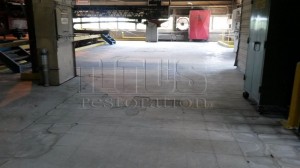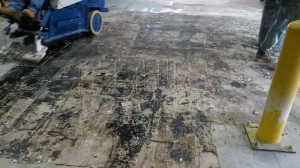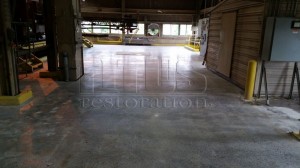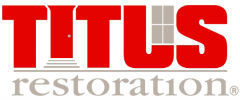If you think you have challenges that might prevent your concrete floors from being renovated, you may be wrong. This industrial concrete restoration project detailed here was challenged by operating on the third level of a heavy industrial manufacturing plant, on the furnace deck, in a 24 hour a day, seven day a week operational area, with machinery working non-stop. The customer was looking for a way to remove the old vinyl composite tile (VCT) that no longer looked presentable, couldn’t be kept clean, and was peeling up in many areas. The customer wanted a floor that was easy to clean and would last longer than the traditional VCT. Here are some images and descriptions of the issues that we were presented with:

It may be difficult to see in the image to the right, but this floor is covered in very old and dirty VCT. You can see in the middle of the image that some of the tiles are peeling up and are in poor general condition. The reason it is so dirty is because of the dust that is produced in this facility during its manufacturing operations. This dust, over time, breaks down the wax on the VCT and it cannot be maintained in the way the owners would like it to be. So what are the options with this old, dingy floor problem?
To make this project more complicated, this floor is located on the third level on the furnace deck. It needs a flooring solution that can handle 100+ degree temperatures and something that will withstand the dust that is produced here. This area of the plant runs 24 hours a day, seven days week, making the floor renovation work difficult to phase around important operation.
Removing the VCT

A tile scraper easily removed VCT and the majority of the mastic underneath. At a rate of 500-2000 square feet per hour depending on how the tile is laid, it comes up with one man on one machine and other crew members disposing of the waste.
Another unforeseen challenge this floor presented was black mastic under the tile. Black mastic, also known as cut back adhesive or VCT adhesive, can be dangerous to remove if it contains asbestos. Each state has its own regulations regarding the removal and disposal of black mastic. On this project, we were able to safely remove the mastic using a wet grinding method. Recovering black mastic material in water in the state of Georgia is acceptable.
Polishing the Concrete under the VCT:
Because the furnace deck is located on the third floor, we had to bring smaller equipment up using a freight elevator. Because the equipment is propane-powered, we didn’t have to haul heavy electrical cords up. Using wet polishers meant we didn’t have to bring up heavy dust collection equipment. A Titus Hybrid™ polished concrete floor offers the same dust proof, durable floor as a high polish floor you would see in a grocery store or car dealership, but it is less shiny. This means there are less steps required and it’s a less expensive process for larger spaces. Here is what the floor looked like when we were finished:

Maintaining the Polished Concrete Floor
No more waxing! Maintenance is easy with polished concrete. Water alone is all that is required to clean most concrete floors. However, if you feel the need to use cleaning products, just make sure they are a neutral pH. Not all green cleaners are neutral, so checking the pH is important. To learn just how easy cleaning polished concrete floors really is, visit our Polished Concrete Maintenance page.
